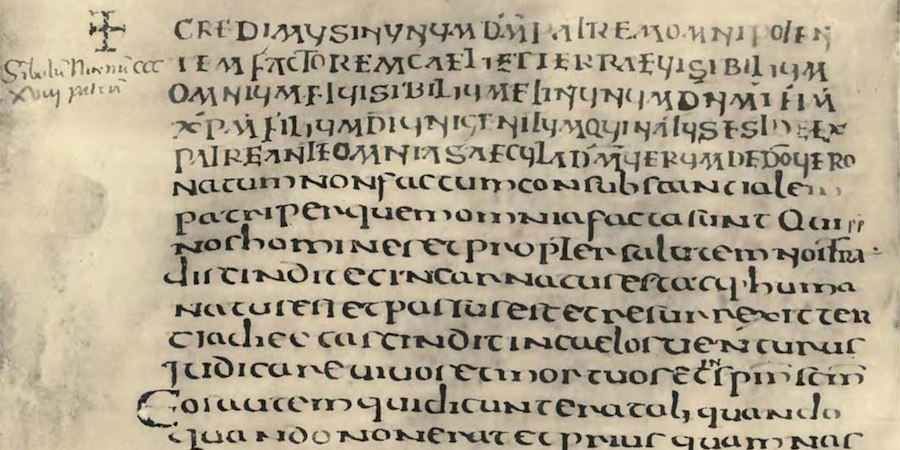
About the Creeds
Connecting Across Time
We read the Nicene Creed aloud together every Sunday during services. Doing so, we participate in an ancient practice that unites with other members of our faith, across history and across the world.
In this article, we’ll take a deeper look at the Nicene Creed, as well as another important creed in our tradition — the Apostle’s Creed — sharing the text and the historical background of each.
The Nicene Creed
We believe in one God,
the Father, the Almighty,
maker of heaven and earth,
of all that is, seen and unseen.
We believe in one Lord, Jesus Christ,
the only Son of God,
eternally begotten of the Father,
God from God, Light from Light,
true God from true God,
begotten, not made,
of one Being with the Father.
Through Him all things were made.
For us and for our salvation
He came down from heaven:
by the power of the Holy Spirit
He became incarnate from the Virgin Mary,
and was made man.
For our sake He was crucified under Pontius Pilate;
He suffered death and was buried.
On the third day He rose again
in accordance with the Scriptures;
He ascended into heaven
and is seated at the right hand of the Father.
He will come again in glory to judge the living and the dead,
and His kingdom will have no end.
We believe in the Holy Spirit, the Lord, the giver of life,
who proceeds from the Father.
With the Father and the Son He is worshiped and glorified.
He has spoken through the Prophets.
We believe in one holy catholic and apostolic Church.
We acknowledge one baptism for the forgiveness of sins.
We look for the resurrection of the dead,
and the life of the world to come. AMEN
Historical Note
During the first three centuries after Christ, the church was dealing with a lot of danger. There was persecution, for one thing. For another, there was the challenge of translating the gospel, which had been formed in a Hebraic and Jewish-Christian context, to a Graeco-Roman world. There were many ideas about Christianity at the time that directly conflicted with biblical witness.
In A.D. 312, Constantine won control of the Roman Empire in the battle of Milvian Bridge. Attributing his victory to the intervention of Jesus Christ, he made Christianity the empire’s official religion. “One God, one Lord, one faith, one church, one empire, one emperor,” was his motto.
Yet the new emperor soon discovered that “one faith” was a sticky goal, since the “one church” was fractured by theological disputes — especially on the nature of Christ, already a long-standing controversy.
The argument had two sides. Arius, a priest of the church in Alexandria, said that the divine Christ, the Word through whom all things exist, was created by God before the beginning of time; therefore the divinity of Christ was similar to the divinity of God, but not in fact the same in essence.
Meanwhile, the bishop Alexander and his successor Athanasius said that the divinity of Christ the Son is of the same substance as the divinity of God the Father. They believed that to hold otherwise was to open the door to polytheism and imply that knowledge of God in Christ was not ultimately knowledge of God.
Constantine wanted to close the rift that was widening within the church, so in A.D. 325 he convened a council in Nicaea, where a creed was written expressing the position of Alexander and Athanasius. A majority of bishops signed it.
Still the debate raged on. So half a century later, in A.D. 381, a second council met in Constantinople, where a revised and expanded form of the original creed was adopted. This was the Nicene Creed.
The Apostle’s Creed
I believe in God, the Father almighty, creator of heaven and earth.
I believe in Jesus Christ, his only Son, our Lord.
He was conceived by the power of the Holy Spirit and born of the Virgin Mary.
He suffered under Pontius Pilate, was crucified, died, and was buried.
He descended to the dead.
On the third day he rose again.
He ascended into heaven, and is seated at the right hand of the Father.
He will come again to judge the living and the dead.
I believe in the Holy Spirit,
the holy catholic Church,
the communion of saints,
the forgiveness of sins,
the resurrection of the body,
and the life everlasting. AMEN
Historical Note
The Symbolum Apostolorum, or Apostle’s Creed, was developed between the second and ninth centuries. It’s the most popular creed used in worship by Western Christians, focusing on the Trinity and God the Creator.
Legend has it that the apostles wrote this creed on the tenth day after Christ’s ascension into heaven. That’s not actually how it came to be, but each of the doctrines in the creed can be traced to statements that came from the apostolic period — and in any case, the name stuck.
The earliest written version of the Apostle’s Creed may be the Interrogatory Creed of Hippolytus (circa A.D. 215), where it takes a question/answer format. It originally appeared in its current form in the writings of Caesarius of Arles (A.D. 542). In Rome, it was used as a summary of Christian doctrine for baptismal candidates; as a result, it’s sometimes called The Roman Symbol.
